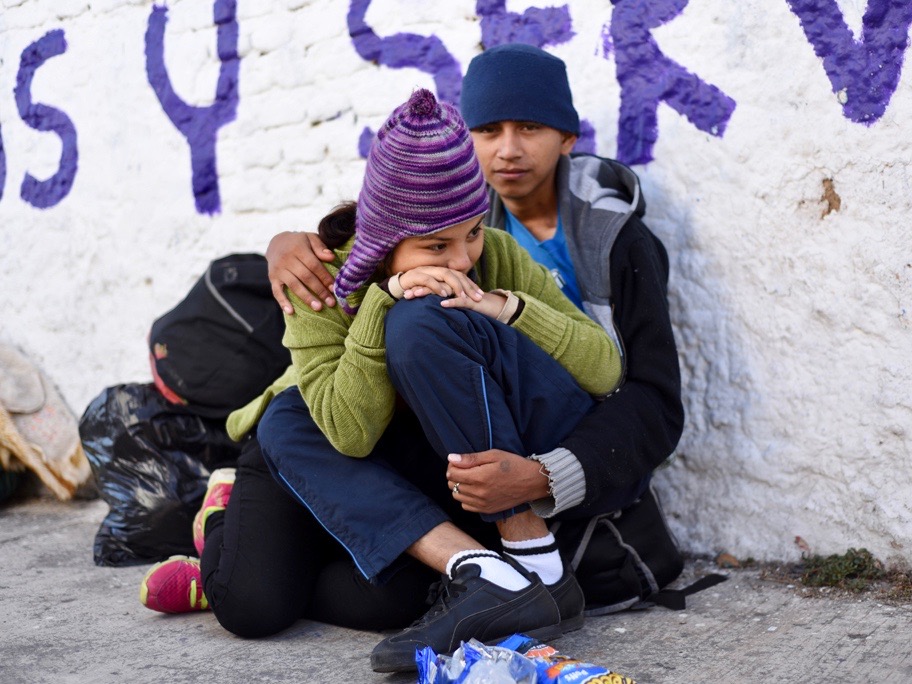We Should Give Sanctuary to Natives from the South
By Doug George-Kanentiio
When I watch the reports of the thousands of people coming north from their homelands in Central America I do not see Hondurans, Guatemalans, El Salvadorians; I see indigenous people, our southern kin, fleeing countries which have become overwhelmed by vicious gangs whose drug money comes directly from sales made in the United States.
Those gangs use violence to force compliance and terror to recruit new members. The national police agencies have been incapable of protecting their citizens resulting in the painful decision to separate from their families, flee their homes and undertake a weeks long journey northwards towards the US knowing their reception will be met with resistance and confinement should they be arrested crossing the border between Mexico and the US.
But the risk of imprisonment is preferable to the threat of death at home. As we watch the immigrants slowly march northwards we see children, single mothers, distraught fathers and even grandparents carrying their meager belongings with jugs of water and small containers of food, relying upon the generosity of the communities they pass through.
The Mexican people have proven to be compassionate but there have been instances where the migrants have been attacked, particularly near Tijuana. Yet they persist even as they are gassed by US border police and labeled as terrorists by a president who uses their displacement as a political weapon, stoking the fear among Americans that waves of criminals are invading the nation.
This is contradicted by the photographs of the refugees. They show families carrying children in wagons, families carrying children on the shoulders of their dads, families with children clinging to their adult relatives and they are clearly indigenous. They are the original people of this hemisphere now compelled to risk all they have for the vague possibility of a better life in a distant land among an unknown people, many of whom are now organized as heavily armed "militia" to use their own version of terror to drive them away from the border.
The migrants are coming in small groups and in waves. They are following the ancient north-south trail from the place where Natives first entered North America tens of thousands of years ago, on a route which carried traders and diplomats. It is the same route taken by the Spanish invaders, the violent and gold mad conquistadors.
Now the Natives are once again on the move. It is not simply a matter of economics but a real and genuine fear, one so powerful it disrupts hundreds of years of communal life.
During the colonial era refugees came from across the salt waters to the east; some were seeking freedom from oppressive regimes but others were indentured servants, criminals or individuals who sought an opportunity to gain material wealth and security. They were often met with generosity by the Native peoples along the seaboard but in most instances the immigrants displaced and destroyed the indigenous nations since land was the most valuable of commodities and the chance to own property was unique to most of them.
Just as with the Natives coming from the south have their humanity qualified by negative stereotypes their relatives to the north also felt the repercussions of having their culture qualified by lies and racist myths. This made it easier to justify the use of violence in both instances. People were, and are, being hurt, they bleed and they die. These are our kin and we should feel compassion for them for they are us.
With all of our resources we have the capacity to sponsor the Native migrants into our home territories. We should use our sovereignty and our common wealth to meet them along their journey and to escort them to our communities.
We should use the traditional Native values of hospitality and kindness along with our ancestral immigrant laws and customs to bring them to places of safety. We should find ways to make use of their strong work ethic to add their abilities to our own. We should blend their DNA with our own, making for a stronger indigenous people.
There are many Native nations which do not have the resources to care for the travelers but many are rich from their various economic activities and could serve as hosts and sponsors. It would represent the best of who we are.
There is also a legal basis for Native people to freely cross into the US. The 1794 Jay Treaty which provides for the following:
Article 3:Note that it refers to the "continent of America" which includes all those nations north of South America. It may be something to consider along with the affirmation that the migrants are indeed Native and making use of a route of commerce and travel which predates the arrival of the colonists from Europe, Doug George-Kanentiio, Akwesasne Mohawk, is the vice-president of the Hiawatha Institute for Indigenous Knowledge. He has served as a Trustee for the National Museum of the American Indian, is a former land claims negotiator for the Mohawk Nation and is the author of numerous books and articles about the Mohawk people. He may be reached via e-mail at: Kanentiio@aol.com or by calling 315-415-7288.
It is agreed that it shall at all Times be free to His Majesty's Subjects, and to the Citizens of the United States, and also to the Indians dwelling on either side of the said Boundary Line freely to pass and repass by Land, or Inland Navigation, into the respective Territories and Countries of the Two Parties on the Continent of America (the Country within the Limits of the Hudson's Bay Company only excepted) and to navigate all the Lakes, Rivers, and waters thereof, and freely to carry on trade and commerce with each other.
Join the Conversation

